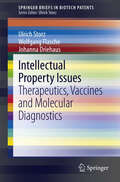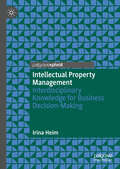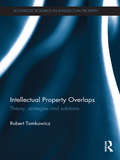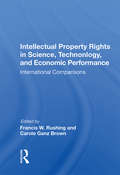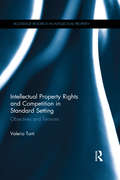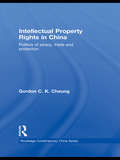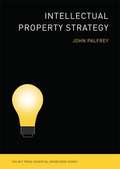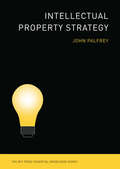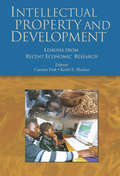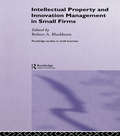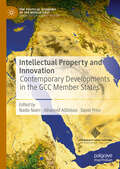- Table View
- List View
Intellectual Property Issues
by Ulrich Storz Johanna Driehaus Wolfgang FlascheSpringerBriefs in Biotech Patents present timely reports of intellectual properties (IP) issues and patent aspects in the field of biotechnology. This new volume in the series focuses on the particular IP issues of therapeutics, vaccines and molecular diagnostics. The first chapter concentrates on basics principles for protecting antibody compounds. Additional ways to create follow-up protection for antibody therapeutics are also discussed. The second chapter gives an overview of the patent landscape in molecular diagnostics, and discusses issues of patentability with respect to the different technologies and compounds used therein. The third chapter gives a broad overview of areas of law that are particularly relevant to the patenting of peptide vaccines and therapeutic peptides as products and in compositions. The scope of patentable subject matter is discussed, as it has been the focus of much wrangling and debate in the courts.
Intellectual Property Law and Access to Medicines: TRIPS Agreement, Health, and Pharmaceuticals (Law, Development and Globalization)
by Srividhya RagavanThe history of patent harmonization is a story of dynamic actors, whose interactions with established structures shaped the patent regime. From the inception of the trade regime to include intellectual property (IP) rights to the present, this book documents the role of different sets of actors – states, transnational business corporations, or civil society groups – and their influence on the structures – such as national and international agreements, organizations, and private entities – that have caused changes to healthcare and access to medication. Presenting the debates over patents, trade, and the Agreement on Trade-Related Aspects of Intellectual Property Rights (TRIPS Agreement), as it galvanized non-state and nonbusiness actors, the book highlights how an alternative framing and understanding of pharmaceutical patent rights emerged: as a public issue, instead of a trade or IP issue. The book thus offers an important analysis of the legal and political dynamics through which the contest for access to lifesaving medication has been, and will continue to be, fought. In addition to academics working in the areas of international law, development, and public health, this book will also be of interest to policy makers, state actors, and others with relevant concerns working in nongovernmental and international organizations.
Intellectual Property Management for Start-ups: Enhancing Value and Leveraging the Potential (Management for Professionals)
by Martin A. Bader Sevim Süzeroğlu-MelchiorsThis book examines intellectual property (IP) as an important value driver for start-ups. Businesses of all sizes are inevitably confronted with intellectual property issues at some point, but start-ups and their collaborators face unique challenges and opportunities in IP management. Identifying, generating, and exploiting intellectual property can lead to sustainable competitive advantages and avoidance of risks. Many start-ups sense the complexity of IP management and therefore place their energy elsewhere. However, the clear conclusion to be drawn from this unique collection of contributions is that putting an IP management strategy in place is critical to the successful development of a business. Prof. Dr. Martin A. Bader and Prof. Dr. Sevim Süzeroğlu-Melchiors have years of experience as consultants, entrepreneurs, business owners, and researchers where they saw firsthand the need for a comprehensive yet practical resource for start-ups and their key stakeholders.This book explores different perspectives in dealing with IP from six different angles: the start-up’s view, the investor’s view, the corporation’s view, the university’s view, the global IP office’s view, and the advisor’s view. Each section consists of chapters written by leading experts from around the globe including Silicon Valley, Canada, Israel, Switzerland, Germany, Finland, France, Australia, Brazil, India, Japan, Singapore, and South Africa. Contributors bring practical experience from a wide range of sectors, such as information and communication technology, software, artificial intelligence, machine learning, cybersecurity, industrial automation, internet of things, life sciences, pharma, crop science, biotech, medtech, mining, sustainability, climate tech, and even quantum technologies. This timely publication serves as a guidebook for entrepreneurs and other key stakeholders in the start-up ecosystem. It empowers founders to develop their own IP management strategy to mitigate risk, create and capture value, and lay the groundwork for sustainable growth. An essential reference for start-ups to achieve business excellence.“This edited book volume offers valuable insights, bringing together perspectives of key stakeholder groups from a wide variety of innovation ecosystems – an invaluable resource.” —Carsten Fink, Chief Economist, World Intellectual Property Organization, Geneva“A timely book for those wanting a clear overview of the issues the different players encounter in the start-up ecosystem. A useful resource indeed. Congratulations to the editors and team.”—Audrey Yap, Managing Partner YUSARN AUDREY LLC, Past President LESI, Chairman Singapore Innovation & Productivity Institute, Singapore“A ‘must read’ for all innovators in the start-up world. It is truly a fantastic book and one I would recommend being bought and read (in full)!”—Laurence Freeman, Professor (Adjunct), CU Denver Business School, Jake Jabs Center for Entrepreneurship, Denver, Colorado, United States
Intellectual Property Management: Interdisciplinary Knowledge for Business Decision-Making
by Irina HeimAn understanding of intellectual property is an essential component of management and business strategy in many industries. It can be used to generate value and create competitive advantage and goes hand-in-hand with the study of technology innovation and international business. However, the literature on intellectual property has been dominated by writers with backgrounds in legal science and economics. This book advocates an interdisciplinary view on intellectual property management for business and management students and professionals. It provides an outline of the field in terms that are tailored to management scholarship and with an emphasis on business decision making. It is intended for business school students of intellectual property management, innovation, strategic management and industry studies, as well as professionals in need of an accessible and business-minded approach to intellectual property management.
Intellectual Property Overlaps: Theory, Strategies, and Solutions (Routledge Research in Intellectual Property)
by Robert TomkowiczIntellectual property rights and their overlaps are considered in light of rights purposes, relying on the concept of a balance of rights as the measuring rod for assessment of the consequences resulting from the exercise of overlapping rights. Identifying the complex interface between different types of intellectual property rights, this book discusses the use of these rights and their effect on a diverse group of stakeholders, from individual users of e-books to large corporations operating search engines on the internet.The book suggests solutions to potentially objectionable uses of overlapping rights in an attempt to provide judiciary and law practitioners with an analytical framework for resolving disputes of overlaps in the intellectual property system. In doing so, the author investigates how use of intellectual property rights associated with one segment of the system can affect the carefully crafted balance of rights held by various stakeholders in an overlapping segment. In particular, the book suggests that a properly construed doctrine of misuse of intellectual property rights would provide an adequate response to the challenge posed by improper use of overlapping intellectual propertyrights.This book is of particular interest to law practitioners, managers in advanced technology and media industries, academics, and university students who work with or analyze intellectual property and new technologies.
Intellectual Property Rights In Science, Technology, And Economic Performance: International Comparisons
by Francis W. Rushing Carole Ganz BrownThis book discusses the economic, political, legal, and social concerns of the world's governments on intellectual property rights. It analyzes the systems of both developed and developing economies and draws a clear picture of the status of intellectual property regimes around the world.
Intellectual Property Rights and ASEAN Development in the Digital Age (Routledge-ERIA Studies in Development Economics)
by Fukunari Kimura Lurong ChenThe trade-investment-service-intellectual property (IP) nexus remains at the heart of economic development and the main features of which are global value chains (GVCs) and digitalisation. The protection of intellectual property rights (IPR) has become a critical issue not only for advanced economies but also for emerging markets. This edited volume contributes to the debates on IPR protection and economic development from the perspective of Association of Southeast Asian Nations (ASEAN) member states. The book provides insights into the mechanism and evidence on how effective IPR protection will increase economic and social welfare via promoting innovation activities and providing incentives to diffuse knowledge and transfer technologies. Written by economists and lawyers from the region, these experts share their latest findings and thoughts on how countries in Southeast Asia have been progressively improving IPR protection and increasing the interoperability of different IPR regimes through regional cooperation to facilitate business operations in the context of digital transformation.
Intellectual Property Rights and Competition in Standard Setting: Objectives and tensions (Routledge Research in Intellectual Property)
by Valerio TortiCompetition and intellectual property rights (IPRs) are both necessary for a market to work efficiently and to promote consumer welfare. Properly applied, intellectual property rules define a legal framework which allows undertakings to profit from their inventions. This in turn encourages competition among firms and enhances dynamic efficiency, to the benefit of consumer welfare. Standard setting represents one of the fields where the interaction between competition law and IPRs clearly comes to light. The collaborative goal of standard setting organizations (SSOs) is to adopt and promote standards that either do not conflict with anyone’s right or, if they do, are developed under condition that patents are licensed under defined terms. This book examines the tension between IPRs and competition in the standard setting field which can arise when innovators over-exploit the rights they have been granted and hold up an entire industry. The book compares EU and U.S. jurisdictions with a particular focus on the IT and telecommunication sectors. It scrutinizes those practices which could harm standard setting and its goals, looking at misleading conducts by SSOs’ members which may lead to breach the EU and U.S. antitrust provisions on abuse of market power. Recent developments in EU and U.S. standard setting are analysed highlighting the differences in enforcement approaches. The book considers how the optimal balance between IPRs and industry standards can be struck, suggesting a policy model which takes into account both innovators’ interests and SSOs’ goals.
Intellectual Property Rights and Global Capitalism: The Political Economy of the TRIPS Agreement
by Donald G. RichardsThis is an examination of the origins and impact of the agreement on Trade-Related Intellectual Property Rights (TRIPS) negotiated during the Uruguay Round of GATT talks. The principal theme is that the TRIPS agreement is not in the best interests of the poorer countries, and that its imposition on them by the richer countries has more to do with the exercise of political and economic power than with the positive economic benefits the agreement's supporters claim it can deliver. To support this assertion the book critically examines the economic evidence regarding the impact of intellectual property rights on such important variables as export performance, foreign investment, and economic growth. The author provides a political economic analysis of why the poorer countries acceded to the TRIPS agreement, illustrated with case studies of two important industries where the struggle over intellectual property is especially strong: pharmaceutical and agricultural biotechnology sectors. Designed for use in advanced undergraduate and graduate courses in international political economy and international relations theory, the book offer a radical view of the process of globalization.
Intellectual Property Rights in China
by Andy Scott Sam Woollard Chris Devonshire-EllisThis Guide is a detailed overview of all aspects of IPR and protection in China. Produced in association with AWS, the Austrian Federal Bank's specialist IPR unit based in Shanghai, this is an essential work for any businessman trading with or conducting business in China. From covering protocol for dealing with Trade Fairs, to the application processes for trademarks, patents, copyright and licensing, as well as dealing with infringements and enforcement,this guide is a practical reference for any businessman with concerned with their IPR in China.
Intellectual Property Rights in China
by Zhenqing ZhangOver the past three decades, China has transformed itself from a stagnant, inward, centrally planned economy into an animated, outward-looking, decentralized market economy. Its rapid growth and trade surpluses have caused uneasiness in Western governments, which perceive this growth to be a result of China's rejection of international protocols that protect intellectual property and its widespread theft and replication of Western technology and products. China's major trading partners, particularly the United States, persistently criticize China for delivering, at best, half-hearted enforcement of intellectual property rights (IPR) norms. Despite these criticisms, Zhenqing Zhang argues that China does respect international intellectual property rights, but only in certain cases. In Intellectual Property Rights in China, Zhang addresses the variation in the effectiveness of China's IPR policy and explains the mechanisms for the uneven compliance with global IPR norms.Covering the areas of patent, copyright, and trademark, Zhang chronicles how Chinese IPR policy has evolved within the legacy of a planned economy and an immature market mechanism. In this environment, compliance with IPR norms is the result of balancing two factors: the need for short-term economic gains that depend on violating others' IPR and the aspirations for long-term sustained growth that requires respecting others' IPR. In case studies grounded in theoretical analysis as well as interviews and fieldwork, Zhang demonstrates how advocates for IPR, typically cutting-edge Chinese companies and foreign IPR holders, can be strong enough to persuade government officials to comply with IPR norms to achieve the country's long-term economic development goals. Conversely, he reveals the ways in which local governments protect IPR infringers because of their own political interests in raising tax revenues and creating jobs.
Intellectual Property Rights in China: Politics of Piracy, Trade and Protection (Routledge Contemporary China Series)
by Gordon C.K CheungIntellectual Property Rights (IPR) infringement is so rampant in China that counterfeit goods - from general household merchandise, garments and media consumables to specialist products including pharmaceutical products and super computer chips - can be found in roadside stalls, markets, shops, department stores and even laboratory of leading universities. If allowed to continue these infringements may further engender a socially accepted culture of ‘fakeness’ that may seriously hamper innovation and economic progress. Gordon C. K. Cheung uses the case of intellectual property rights (IPR) to examine how and to what extent market forces and knowledge development affect the relationships of China and the world, especially the United States. Including detailed original statistics and data collected from Chinese provinces and cities and in-depth interviews with legal experts and policy makers, this book gives a unique insight into the opportunities and challenges that China faces as it increasingly becomes part of the global society. Intellectual Property Rights in China is a stimulating read for anyone studying Chinese Business and International Political Economy.
Intellectual Property Rights, Copynorm and the Fashion Industry: A Comparative Analysis
by Marlena JankowskaThis book traces the development of the fashion industry, providing insight into the business and, in particular, its interrelations with copyright law. The book explores how the greatest haute couture fashion designers also had a sense for business and that their attention to copyright was one of the weapons in protecting their market position. The work also confronts the peculiarities of the fashion industry as a means of demonstrating the importance of intellectual property protection while pointing out the many challenges involved. A central aim is to provide a copyrightability test for fashion goods based on detailed analysis of the legal regulations in the USA and EU countries, specifically Italy, France, the Netherlands, Germany and Poland. The book will be of interest to researchers and academics working in the areas of Intellectual Property Law, Copyright Law, Business Law, Fashion Law and Design.
Intellectual Property Rights, Copynorm and the Fashion Industry: A Comparative Analysis
by Marlena JankowskaThis book traces the development of the fashion industry, providing insight into the business and, in particular, its interrelations with copyright law. The book explores how the greatest haute couture fashion designers also had a sense for business and that their attention to copyright was one of the weapons in protecting their market position. The work also confronts the peculiarities of the fashion industry as a means of demonstrating the importance of intellectual property protection while pointing out the many challenges involved. A central aim is to provide a copyrightability test for fashion goods based on detailed analysis of the legal regulations in the USA and EU countries, specifically Italy, France, the Netherlands, Germany and Poland. The book will be of interest to researchers and academics working in the areas of Intellectual Property Law, Copyright Law, Business Law, Fashion Law and Design.
Intellectual Property Statistics: Measuring Framework for Standards and Trade in Ideas (Contributions to Economics)
by Eskil UllbergPatents and other intellectual property (IP) rights are increasingly part of cross-border trade in their own rights. Patent transfers and patent licensing between inventors, investors and innovators create new business strategies of cooperation in the creation of new technology – increasing the productivity in the stock of technology assets – and efficient “distribution” of these rights. The rights bundles are then used – also increasingly – in products and services being traded cross-border, furthering economic efficiency created by this cooperative strategy. Today’s international trade statistics, however, lack statistics explicitly on trade flows from ideas, based on IP rights. This book offers an idea based statistical framework to measure IP, (i.e., increasingly depends on trade in ideas) and explores ways to introduce the framework into international standards. Specifically, it offers a theory of value to measure the flows from IP and an asset view of IP to deal with allocation of resources and who owns these rights. This is then contrasted with the current way IP is treated and a “gap analysis” is used to identify what needs to change in the standards. This new framework can help develop theories, policies, practices and inform the decisions needed to better leverage the human capital formation of inventors everywhere. Praise for Intellectual Property Statistics… “In this book, Prof. Ullberg has undertaken a Herculean task – to lay out a paradigm for the collection of IP Statistics to ensure that the … market of trade in ideas has the information and data necessary to function well. [the] volume should be viewed as a starting point, a work in progress, but an important one that could very well influence the development of this important set of data on trade in ideas. At a time when global issues … require both new ideas and the spread of those ideas widely to help ensure both economic growth and continued global economic convergence data that helps us monitor and evaluate what is happening in trade in ideas will be extremely valuable.” – Robert Koopman, American University, Washington, DC, USA and Former Chief Economist, World Trade Organization, Geneva, Switzerland
Intellectual Property Strategy
by John PalfreyMost managers leave intellectual property issues to the legal department, unaware that an organization's intellectual property can help accomplish a range of management goals, from accessing new markets to improving existing products to generating new revenue streams. In this book, intellectual property expert and Harvard Law School professor John Palfrey offers a short briefing on intellectual property strategy for corporate managers and nonprofit administrators. Palfrey argues for strategies that go beyond the traditional highly restrictive "sword and shield" approach, suggesting that flexibility and creativity are essential to a profitable long-term intellectual property strategy--especially in an era of changing attitudes about media. Intellectual property, writes Palfrey, should be considered a key strategic asset class. Almost every organization has an intellectual property portfolio of some value and therefore the need for an intellectual property strategy. A brand, for example, is an important form of intellectual property, as is any information managed and produced by an organization. Palfrey identifies the essential areas of intellectual property--patent, copyright, trademark, and trade secret--and describes strategic approaches to each in a variety of organizational contexts, based on four basic steps. The most innovative organizations employ multiple intellectual property approaches, depending on the situation, asking hard, context-specific questions. By doing so, they achieve both short- and long-term benefits while positioning themselves for success in the global information economy.
Intellectual Property Strategy (The MIT Press Essential Knowledge series)
by John PalfreyHow a flexible and creative approach to intellectual property can help an organization accomplish goals ranging from building market share to expanding an industry.Most managers leave intellectual property issues to the legal department, unaware that an organization's intellectual property can help accomplish a range of management goals, from accessing new markets to improving existing products to generating new revenue streams. In this book, intellectual property expert and Harvard Law School professor John Palfrey offers a short briefing on intellectual property strategy for corporate managers and nonprofit administrators. Palfrey argues for strategies that go beyond the traditional highly restrictive “sword and shield” approach, suggesting that flexibility and creativity are essential to a profitable long-term intellectual property strategy—especially in an era of changing attitudes about media.Intellectual property, writes Palfrey, should be considered a key strategic asset class. Almost every organization has an intellectual property portfolio of some value and therefore the need for an intellectual property strategy. A brand, for example, is an important form of intellectual property, as is any information managed and produced by an organization. Palfrey identifies the essential areas of intellectual property—patent, copyright, trademark, and trade secret—and describes strategic approaches to each in a variety of organizational contexts, based on four basic steps.The most innovative organizations employ multiple intellectual property approaches, depending on the situation, asking hard, context-specific questions. By doing so, they achieve both short- and long-term benefits while positioning themselves for success in the global information economy.
Intellectual Property Strategy at North Technology Group-Sailing Downwind
by Felix Oberholzer-Gee William W. Fisher IIINorth Sails is the world's leading sailmaker. The company commands a global market share of more than 50% and is largely responsible for the rapid technological progress in the sailmaking industry over the past 30 years. CEO Tom Whidden needs to consider how to best defend the company's leading position. Specifically, North currently uses neither patents nor copyright to protect its technology. The company even allows its designers to use its software when they do independent work. The case encourages a discussion of the role of intellectual property rights in safeguarding technology and know-how. By highlighting the costs and benefits of patents and copyright, the case points to a challenge that is common across many companies: Their most valuable assets are largely intangible, and these assets cannot easily be pinned down and protected. North's solution to this challenge is highly unusual and creative.
Intellectual Property and Development
by Carsten Fink Keith E. MaskusInternational policies toward protecting intellectual property rights have seen profound changes over the past two decades. Rules on how to protect patents, copyright, trademarks and other forms of intellectual property have become a standard component of international trade agreements. Most significantly, during the Uruguay Round of multilateral trade negotiations (1986-94), members of what is today the World Trade Organization (WTO) concluded the Agreement on Trade Related Intellectual Property Rights (TRIPS), which sets out minimum standards of protection that most of the world's economies have to respect. How will developing countries fare in this new international environment? Intellectual Property and Development brings together empirical research that assesses the effects of changing intellectual property regimes on various measures of economic and social performance - ranging from international trade, foreign investment and competition, to innovation and access to new technologies. The studies presented point to an important development dimension to the protection of intellectual property. But a one-size fits all approach to intellectual property is unlikely to work. There is need to adjust intellectual property norms to domestic needs, taking into account developing countries' capacity to innovate, technological needs, and institutional capabilities. In addition, governments need to consider a range of complementary policies to maximize the benefits and reduce the costs of reformed intellectual property regulations. This book will be of interest to students and scholars of international law, particularly in the area of intellectual property rights, international trade, and public policy.
Intellectual Property and Development
by Rami M. OlwanThe book examines the correlation between Intellectual Property Law - notably copyright - on the one hand and social and economic development on the other. The main focus of the initial overview is on historical, legal, economic and cultural aspects. Building on that, the work subsequently investigates how intellectual property systems have to be designed in order to foster social and economic growth in developing countries and puts forward theoretical and practical solutions that should be considered and implemented by policy makers, legal experts and the Word Intellectual Property Organization (WIPO).
Intellectual Property and Financing Strategies for Technology Startups
by Jr. Gerald B. Halt John C. Donch Amber R. Stiles Robert FesnakThis book offers a comprehensive, easy to understand guide for startup entities and developing companies, providing insight on the various sources of funding that are available, how these funding sources are useful at each stage of a company's development, and offers a comprehensive intellectual property strategy that parallels each stage of development. The IP strategies offered in this book take into consideration the goals that most startups and companies have at each stage of development, as well as the limitations that exist at each stage (i. e. , limited available resources earmarked for intellectual property asset development), and provides solutions that startups and companies can implement to maximize their return on intellectual property investments. This book also includes a number of descriptive examples, case studies and scenarios to illustrate the topics discussed, and is intended for use by startups and companies across all industries. Readers will garner an appreciation for the value that intellectual property rights provide to a startup entity or company and will gain an understanding of the types of intellectual property rights that are available to companies and how to procure, utilize and monetize those intellectual property rights to help their company grow.
Intellectual Property and Free Trade Agreements in the Asia-Pacific Region
by Reto M. Hilty Christoph AntonsThis book is highly topical. The shift from the multilateral WTO negotiations to bilateral and regional Free Trade Agreements has been going on for some time, but it is bound to accelerate after the WTO Doha round of negotiations is now widely regarded as a failure. However, there is a particular regional angle to this topic as well. After concluding that further progress in the Doha round was unlikely, Pacific Rim nations recently have progressed with the negotiations of a greatly expanded Trans-Pacific Partnership Agreement that includes industrialised economies and developed countries such as the United States, Japan, Australia and New Zealand, recently emerged economies such as Singapore, but also several developing countries in Asia and Latin America such as Malaysia and Vietnam. US and EU led efforts to conclude FTAs with Asia-Pacific nations are also bound to accelerate again, after a temporary slowdown in the negotiations following the change of government in the United States and the expiry of the US President's fast-track negotiation authority. The book will provide an assessment of these dynamics in the world's fastest growing region. It will look at the IP chapters from a legal perspective, but also put the developments into a socio-economic and political context. Many agreements in fact are concluded because of this context rather than for purely economic reasons or to achieve progress in fields like IP law. The structure of the book follows an outline that groups countries into interest alliances according to their respective IP priorities. This ranges from the driving forces of the EU, US and Japan, via Asia-Pacific resource-rich but IP poor economies such as Australia and New Zealand, recently emerged economies with strong IP systems such as Singapore and Korea to leading developing countries such as China and India and 'second tier industrializing economies' such as Thailand, Malaysia and Indonesia.
Intellectual Property and Innovation Management in Small Firms (Routledge Studies in Entrepreneurship and Small Business)
by Robert BlackburnIntellectual property protection is increasingly becoming a central issue for businesses. This book provides a wealth of original research on intellectual property management in small and medium sized enterprises, while also addressing the context of innovation and knowledge management.
Intellectual Property and Innovation: Contemporary Developments in the GCC Member States (The Political Economy of the Middle East)
by David Price Alhanoof AlDebasi Nadia NaimThis book examines the notion and understanding of innovation and knowledge societies as they particularly apply to the Gulf states and their broad range of communities. Key to this examination will be the role that intellectual property - its promotion and protection – plays in fostering both innovation and the knowledge society. In brief, innovation, knowledge, society, emerging technology, economic growth and intellectual property are intertwined and inseparable. Unique to the GCC, is the constitutional significance of Islamic Law and the book discusses intellectual property growth in line with economic developments in the region and reflects on Islamic Finance Law.
Intellectual Property and Strategy
by David B. Yoffie Debbie FreierExplores the role of intellectual property in firms' strategies. Explains the legal and strategic differences between patents, copyrights, trademarks, and trade secrets and explores the multiple ways firms use these different legal protections to gain competitive advantage in the marketplace.
